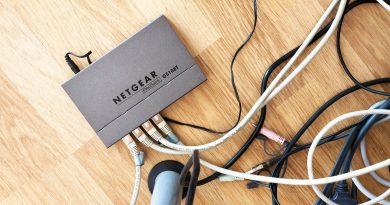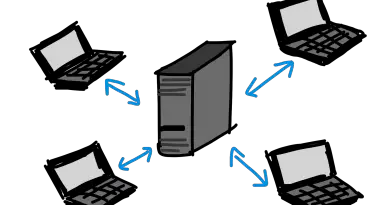Computer Network – Addressing (Port , Logical , Specific and Physical Address Basic Overview )
We already know that in any network transmission model, any two devices shall start communication by the virtue of their unique address. In simple words, we can say that if any two devices want to engage in any kind of dialogue (communication), then they should first identify themselves in this complex network transmission arena. So first they should know each other’s respective addresses (of source and destination) .
In the internet employing TCP/IP protocol, we have four levels of addresses being in use for different layers. Now let us see the different addressing methods in detail.
Four types of addressing methods used are the following :
- Physical address
- Logical address (IP)
- Port address and
- Specific address
Before we dig deep into each type of addressing, we should first understand the respective mapping (implementation) of each address in each of the layers of TCP/IP model:
| TCP/IP Layer | Addressing Used |
| Application layer | Specific address |
| Transport layer | Port address |
| Network or Internet Layer | Logical address |
| Data link layer/Physical layer |
Physical address |
1. MAC Addresses (Physical Address):
It is also known as the ‘Link address‘ . It is basically the address of any particular node that has been described by the LAN or WAN (already covered in the previous post).
It is further included inside the frame which is utilized by the DLL (data link layer) of OSI model. It is the bottom-most layer (bottom-most address in OSI model) address.
The packets through the source to destination hosts move across physical networks. The internet protocol address details is not useful however the host and routers are acknowledged by their MAC addresses .
A MAC address is basically a local address. It will be unique locally but it is not unique universally. The format and size of this kind of address will further change depending on the network.
Most importantly we should be able to map an IP address into a corresponding MAC address.
The size and format of any physical address vary depending on the nature of network.
The Ethernet (LAN) uses a 48-bit (6-byte) physical address which is normally produced in the network interfacing card (NIC).
The sender computer with a physical address of 15 wants of communicate with the receiver computer with a physical address 54.
The frame sent by any sender consists of the destination address,senders address,encapsulated data, and a trailer that contains the error control bit.
When this frame travels over the bus topology ,each and every computer receives it and tries to match it with its own physical address.Each of the stations having a physical address which is other than 54 declines the frame simply because the destination target contained in the framework doesn’t match it’s very own physical address .
If the destination address in the frame header does not match with the physical address it will simply drop the frame.
At receiver computer(D) the destinations address matches with its physical address (54).So the frame is accepted and decapsulation is carried out to recover the data.Thus finally the frame is checked, the header and the trailer are dropped, and the data part is then decapsulated and delivered to the upper layer.
2. Logical Address(IP Addresses):
Logical address is required to facilitate universal communication in which different types of the physical networks can be involved. In a universal addressing system, every single host will be recognized individually, regardless of any fundamental physical network.
The logical address is also called the IP (Internet Protocol) address.
The internet consists of many physical networks interconnected via devices like routers.
Internet is a packed switched networked that means the data from the source computer is sent in the form of small packets carrying the destination address upon them.
A packet starts from the source host,passes through many physical networks, and finally reaches the destination host.When the frame reaches the destination, the packet is then decapsulated.
The destination logical address further matches the logical address of a particular computer. The data are then finally decapsulated from the packet and then delivered (forwarded) to the upper layer.
The message frame is initially received by every unit on the LAN network , but is then declined by all apart from the necessarily required router, which ultimately realizes that the location destination address in the frame fits with its own target physical address. The router then finally decapsulates the data packet in order to retrieve the destination logical address .
At the network level , the hosts and routers are further recognised by their IP Addresses.Note that although the physical addresses will change itself from the hop to hop movement (each jump transition) , the logical addresses will remain the same from the source to destination .
An IP address is an internetwork address .It is a universally unique address.
Every protocol involved in internetwork requires IP address.The logical address used on the internet is currently a 32-bit address . The same IP address can be used by more than one computer on the internet.
3. Port Address:
The IP and Physical address are essential for any level of data traveling from the certain specific source to the destination host that is required. But in today’s modern computers, we may require to run multiple processes on it simultaneously.
Let us suppose a computer says ‘A’ first initiate communication with another computer named ‘C’ by using TELNET. Further, consider now, the same computer ‘A’ communicates with any computer ‘B’ simultaneously by means of the File Transfer Protocol (FTP) .
The main objective of the internet is the process to process communications. For this purpose, it is necessary to label or name a specific process.
Thus the process needs addresses. The label that is allocated to a process is known as the port address.It is a 16 bit address field .
The physical addresses change for each and every trip a packet takes, but the logical and port addresses basically will remain as it is.
4. Specific Addresses:
A few of the applications generally have simple (easy to use) address. Examples of specific addresses are the e-mail addresses of the University Resource Locators(URL).
Examples mainly consist of the email address (for eg, electronicscrunch@gmail.com) and the Universal Resource Locator (URL) (for eg , www.gmail.com).
These kinds of addresses are designed for a specific address. However, this address gets changed according to the required logical and port addresses sent from the sender computer.
So this is it from this topic of different addressing methods implemented in TCP/IP architecture. From the next post onwards we will start looking into each of the protocols in detail. So stay tuned.

Aric is a tech enthusiast , who love to write about the tech related products and ‘How To’ blogs . IT Engineer by profession , right now working in the Automation field in a Software product company . The other hobbies includes singing , trekking and writing blogs .




